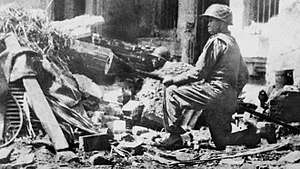Battle of Hanoi (1946)
| Battle of Hanoi | |||||||
|---|---|---|---|---|---|---|---|
| Part of the First Indochina War | |||||||
 Vietnamese soldier holding the Lunge Mine at Hàng Đậu Street on December 1946 | |||||||
| |||||||
| Belligerents | |||||||
|
|
| ||||||
| Commanders and leaders | |||||||
|
Louis Morlière Pierre-Louis Débes | Vương Thừa Vũ | ||||||
On December 19, 1946, Viet Minh soldiers detonated explosives in Hanoi, and the ensuing battle, known as the Battle of Hanoi marked the opening salvo of the First Indochina War.
History
The explosives, set off at 20:03 in the evening, had been smuggled past French Army guards into the city's power plant. The resulting explosion plunged Hanoi into darkness, and throughout the city the Viet-Minh began attacking French military positions and French homes.[1] Surviving French troops, alerted by friendly spies, gradually gained a numerical superiority. French artillery shelled the city, and house to house searches were conducted searching for the Viet-Minh leadership.
Ho Chi Minh was at the time ill with fever, and Võ Nguyên Giáp ordered "all soldiers... to stand together, go into battle, destroy the invaders, and save the nation". Eventual French superiority in firepower forced the Viet-Minh to withdraw to mountains 80 miles to the north of the Hanoi.[2] However, it took the French 60 days to gain complete control of the city, which had bought enough time for their enemy to evacuate all of its central offices, as well as most of its main forces. After expunging the Viet-Minh from the city, the French demanded the military surrender of their opponents, but the latter refused. The United States, alarmed at the incident, dispatched Abbot Low Moffat on a special mission to Saigon and Hanoi to consider a negotiated referendum. However, the realization that the Viet-Minh would not accept compromise led to the US abandoning the idea.[3]
Gallery
Memorials
- Monument Determined to Brave Death for the Survival of the Fatherland by artist Nguyễn-kim-Giao at Hàng-Dầu Street.
- Monument Determined to Brave Death for the Survival of the Fatherland by artists Vũ-đại-Bình and Mai-văn-Kế at Vạn-Xuân Park.
- Bronze sculpture Lunge Mine soldier by artist Trần-văn-Hòe.
- Sculpture Hanoi in the winter 1946 by Ngũ-xã's artists at the Đồng-Xuân Market.
References
- ↑ Bradley, Mark Philip (2009-05-15). Vietnam at war. Oxford University Press. p. 47. ISBN 978-0-19-280349-8.
- ↑ Vo, Nghia M. (2006). The Vietnamese boat people, 1954 and 1975-1992. McFarland. p. 13. ISBN 978-0-7864-2345-3.
- ↑ Schulzinger, Robert D. (1998-12-01). A time for war: the United States and Vietnam, 1941-1975. Oxford University Press US. pp. 28–31. ISBN 978-0-19-512501-6.
- Hammer, Ellen Joy (1954). The struggle for Indochina. Stanford University Press.
- Buttinger, Joseph (1972). A dragon defiant: a short history of Vietnam. Praeger.
- Fall, Bernard B. (1967). Hell in a very small place: the siege of Dien Bien Phu. Lippincott.
- Kedward, Rod (2006). La vie en bleu: France and the French since 1900. Penguin. ISBN 978-0-14-013095-9.
- Roy, Jules (1963). The battle of Dienbienphu. Pyramid Books.
- Windrow, Martin (2005-12-26). The Last Valley: Dien Bien Phu and the French Defeat in Vietnam. Da Capo Press. ISBN 978-0-306-81443-3.
- Fall, Bernard B. (1994). Street without joy. Stackpole Books. ISBN 978-0-8117-1700-7.
- Devillers, Philippe; Lacouture, Jean (1969). End of a war; Indochina, 1954. Praeger.
- Fall, Bernard B. (1963). The two Viet-Nams: a political and military analysis. Praeger.



